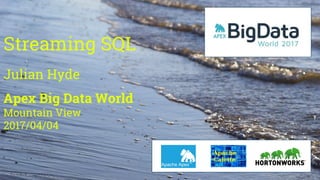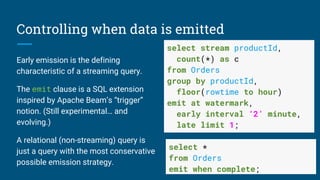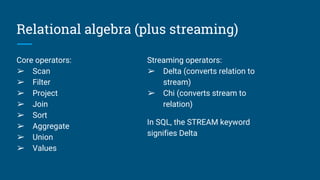Streaming SQL
- 1. Streaming SQL Julian Hyde Apex Big Data World Mountain View 2017/04/04
- 2. @julianhyde SQL Query planning Query federation OLAP Streaming Hadoop Apache member Original author of Apache Calcite PMC Apache Arrow, Drill, Eagle, Kylin
- 3. Data center Why SQL? Data in motion, data at rest - it’s all just data Stream / database duality SQL is the best language ever created for data (because it’s declarative)
- 4. Building a streaming SQL standard via consensus Please! No more “SQL-like” languages! Key technologies are open source (many are Apache projects) Calcite is providing leadership: developing example queries, TCK Complements Apache Beam’s work on a common streaming API/algebra (Optional) Use Calcite’s framework to build a streaming SQL parser/planner for your engine Several projects are working with us: Apex, Flink, Samza, Storm. (Also non-streaming SQL in Cassandra, Drill, Druid, Elasticsearch, Hive, Kylin, Phoenix.)
- 5. SQL in Apex SQL support is part of Malhar (malhar-sql) [1] Disclaimer: Not everything I describe today is in Apex Operators: Scan, Filter, Project Coming soon: Window operators [1] https://www.datatorrent.com/blog/sql-apache-apex/
- 6. Simple queries select * from Products where unitPrice < 20 select stream * from Orders where units > 1000 ➢ Traditional (non-streaming) ➢ Products is a table ➢ Retrieves records from -∞ to now ➢ Streaming ➢ Orders is a stream ➢ Retrieves records from now to +∞ ➢ Query never terminates
- 7. Stream-table duality select * from Orders where units > 1000 ➢ Yes, you can use a stream as a table ➢ And you can use a table as a stream ➢ Actually, Orders is both ➢ Use the stream keyword ➢ Where to actually find the data? That’s up to the system select stream * from Orders where units > 1000
- 8. Combining past and future select stream * from Orders as o where units > ( select avg(units) from Orders as h where h.productId = o.productId and h.rowtime > o.rowtime - interval ‘1’ year) ➢ Orders is used as both stream and table ➢ System determines where to find the records ➢ Query is invalid if records are not available
- 9. Semantics of streaming queries The replay principle: A streaming query produces the same result as the corresponding non-streaming query would if given the same data in a table. Output must not rely on implicit information (arrival order, arrival time, processing time, or watermarks/punctuations) (Some triggering schemes allow records to be emitted early and re-stated if incorrect.)
- 10. Controlling when data is emitted Early emission is the defining characteristic of a streaming query. The emit clause is a SQL extension inspired by Apache Beam’s “trigger” notion. (Still experimental… and evolving.) A relational (non-streaming) query is just a query with the most conservative possible emission strategy. select stream productId, count(*) as c from Orders group by productId, floor(rowtime to hour) emit at watermark, early interval ‘2’ minute, late limit 1; select * from Orders emit when complete;
- 11. Aggregation and windows on streams GROUP BY aggregates multiple rows into sub-totals ➢ In regular GROUP BY each row contributes to exactly one sub-total ➢ In multi-GROUP BY (e.g. HOP, GROUPING SETS) a row can contribute to more than one sub-total Window functions (OVER) leave the number of rows unchanged, but compute extra expressions for each row (based on neighboring rows) Multi GROUP BY Window functions GROUP BY
- 12. Tumbling, hopping & session windows in SQL Tumbling window Hopping window Session window select stream … from Orders group by floor(rowtime to hour) select stream … from Orders group by tumble(rowtime, interval ‘1’ hour) select stream … from Orders group by hop(rowtime, interval ‘1’ hour, interval ‘2’ hour) select stream … from Orders group by session(rowtime, interval ‘1’ hour)
- 13. The “pie chart” problem ➢ Task: Write a web page summarizing orders over the last hour ➢ Problem: The Orders stream only contains the current few records ➢ Solution: Materialize short-term history Orders over the last hour Beer 48% Cheese 30% Wine 22% select productId, count(*) from Orders where rowtime > current_timestamp - interval ‘1’ hour group by productId
- 14. Join stream to a table Inputs are the Orders stream and the Products table, output is a stream. Acts as a “lookup”. Execute by caching the table in a hash-map (if table is not too large) and stream order will be preserved. What if Products table is being modified while query executes? select stream * from Orders as o join Products as p on o.productId = p.productId
- 15. Join stream to a stream We can join streams if the join condition forces them into “lock step”, within a window (in this case, 1 hour). Which stream to put input a hash table? It depends on relative rates, outer joins, and how we’d like the output sorted. select stream * from Orders as o join Shipments as s on o.productId = p.productId and s.rowtime between o.rowtime and o.rowtime + interval ‘1’ hour
- 16. Other operations Other relational operations make sense on streams (usually only if there is an implicit time bound). Examples: ● order by - E.g. Each hour emit the top 10 selling products ● union - E.g. Merge streams of orders and shipments ● insert, update, delete - E.g. Continuously insert into an external table ● exists, in sub-queries - E.g. Show me shipments of products for which there has been no order in the last hour ● view - Expanded when query is parsed; zero runtime cost ● match_recognize - Complex event processing (CEP)
- 17. Planning queries MySQL Splunk join Key: productId group Key: productName Agg: count filter Condition: action = 'purchase' sort Key: c desc scan scan Table: products select p.productName, count(*) as c from splunk.splunk as s join mysql.products as p on s.productId = p.productId where s.action = 'purchase' group by p.productName order by c desc Table: splunk
- 18. Optimized query MySQL Splunk join Key: productId group Key: productName Agg: count filter Condition: action = 'purchase' sort Key: c desc scan scan Table: splunk Table: products select p.productName, count(*) as c from splunk.splunk as s join mysql.products as p on s.productId = p.productId where s.action = 'purchase' group by p.productName order by c desc
- 19. Apache Calcite Apache top-level project since October, 2015 Query planning framework ➢ Relational algebra, rewrite rules ➢ Cost model & statistics ➢ Federation via adapters ➢ Extensible Packaging ➢ Library ➢ Optional SQL parser, JDBC server ➢ Community-authored rules, adapters Embedded Adapters Streaming Apache Drill Apache Hive Apache Kylin Apache Phoenix* Cascading Lingual Apache Cassandra Apache Spark CSV Druid Elasticsearch In-memory JDBC JSON MongoDB Splunk Web tables Apache Apex Apache Flink Apache Samza Apache Storm * Under development
- 20. Join the community! Calcite and Apex are projects of the Apache Software Foundation The Apache Way: meritocracy, openness, consensus, community We welcome new contributors!
- 21. Thank you! @julianhyde @ApacheCalcite http://calcite.apache.org http://calcite.apache.org/docs/stream.html References ● Hyde, Julian. "Data in flight." Communications of the ACM 53.1 (2010): 48-52. [pdf] ● Akidau, Tyler, et al. "The dataflow model: a practical approach to balancing correctness, latency, and cost in massive-scale, unbounded, out-of-order data processing." Proceedings of the VLDB Endowment 8.12 (2015): 1792-1803. [pdf] ● Arasu, Arvind, Shivnath Babu, and Jennifer Widom. "The CQL continuous query language: semantic foundations and query execution." The VLDB Journal—The International Journal on Very Large Data Bases 15.2 (2006): 121-142. [pdf]
- 22. Extra slides
- 23. Summary Features of streaming SQL: ● Standard SQL over streams and relations ● Relational queries on streams, and vice versa ● Materialized views and standing queries Benefits: ● Brings streaming data to DB tools and traditional users ● Brings historic data to message-oriented applications ● Lets the system optimize quality of service (QoS) and data location
- 24. Why SQL? ● API to your database ● Ask for what you want, system decides how to get it ● Query planner (optimizer) converts logical queries to physical plans ● Mathematically sound language (relational algebra) ● For all data, not just data in a database ● Opportunity for novel data organizations & algorithms ● Standard https://www.flickr.com/photos/pere/523019984/ (CC BY-NC-SA 2.0) ➢ API to your database ➢ Ask for what you want, system decides how to get it ➢ Query planner (optimizer) converts logical queries to physical plans ➢ Mathematically sound language (relational algebra) ➢ For all data, not just “flat” data in a database ➢ Opportunity for novel data organizations & algorithms ➢ Standard Why SQL?
- 26. Relational algebra (plus streaming) Core operators: ➢ Scan ➢ Filter ➢ Project ➢ Join ➢ Sort ➢ Aggregate ➢ Union ➢ Values Streaming operators: ➢ Delta (converts relation to stream) ➢ Chi (converts stream to relation) In SQL, the STREAM keyword signifies Delta
- 27. Streaming algebra ➢ Filter ➢ Route ➢ Partition ➢ Round-robin ➢ Queue ➢ Aggregate ➢ Merge ➢ Store ➢ Replay ➢ Sort ➢ Lookup
- 28. Optimizing streaming queries The usual relational transformations still apply: push filters and projects towards sources, eliminate empty inputs, etc. The transformations for delta are mostly simple: ➢ Delta(Filter(r, predicate)) → Filter(Delta(r), predicate) ➢ Delta(Project(r, e0, ...)) → Project(Delta(r), e0, …) ➢ Delta(Union(r0, r1), ALL) → Union(Delta(r0), Delta(r1)) But not always: ➢ Delta(Join(r0, r1, predicate)) → Union(Join(r0, Delta(r1)), Join(Delta(r0), r1) ➢ Delta(Scan(aTable)) → Empty
- 29. Sliding windows in SQL select stream sum(units) over w (partition by productId) as units1hp, sum(units) over w as units1h, rowtime, productId, units from Orders window w as (order by rowtime range interval ‘1’ hour preceding) rowtime productId units 09:12 100 5 09:25 130 10 09:59 100 3 10:17 100 10 units1hp units1h rowtime productId units 5 5 09:12 100 5 10 15 09:25 130 10 8 18 09:59 100 3 23 13 10:17 100 10
- 30. Join stream to a changing table Execution is more difficult if the Products table is being changed while the query executes. To do things properly (e.g. to get the same results when we re-play the data), we’d need temporal database semantics. (Sometimes doing things properly is too expensive.) select stream * from Orders as o join Products as p on o.productId = p.productId and o.rowtime between p.startEffectiveDate and p.endEffectiveDate





![SQL in Apex
SQL support is part of Malhar
(malhar-sql) [1]
Disclaimer: Not everything I
describe today is in Apex
Operators: Scan, Filter, Project
Coming soon: Window operators
[1] https://www.datatorrent.com/blog/sql-apache-apex/](https://image.slidesharecdn.com/calcite-streaming-sql-apex-2017-170404191828/85/Streaming-SQL-5-320.jpg)















![Thank you!
@julianhyde
@ApacheCalcite
http://calcite.apache.org
http://calcite.apache.org/docs/stream.html
References
● Hyde, Julian. "Data in flight." Communications of the ACM 53.1
(2010): 48-52. [pdf]
● Akidau, Tyler, et al. "The dataflow model: a practical approach to
balancing correctness, latency, and cost in massive-scale,
unbounded, out-of-order data processing." Proceedings of the
VLDB Endowment 8.12 (2015): 1792-1803. [pdf]
● Arasu, Arvind, Shivnath Babu, and Jennifer Widom. "The CQL
continuous query language: semantic foundations and query
execution." The VLDB Journal—The International Journal on Very
Large Data Bases 15.2 (2006): 121-142. [pdf]](https://image.slidesharecdn.com/calcite-streaming-sql-apex-2017-170404191828/85/Streaming-SQL-21-320.jpg)








